Psych 1010 Exam 2 (uLeth)
1/249
Earn XP
Description and Tags
Flashcard set for Psych 1010 exam 2 (uLeth)
Name | Mastery | Learn | Test | Matching | Spaced |
|---|
No study sessions yet.
250 Terms
Consciousness
One’s moment-to-moment subjective experience of the world - Continuous stream
Qualia
The qualitative experiences of your conscious state - Subjective experiences of sensation
Change blindness
A failure to notice large changes in one’s environment
How do the limits on consciousness contribute to change blindness?
Major changes to the environment may go unnoticed when conscious awareness is focused elsewhere
Stressor
Anything that pushes the bodily systems out of homeostasis (physical or psychological)
Stress response
The suite of psychological + behavioral responses to return the body to homeostasis - An adaptive response of all psychological systems (with brain) to mobilize for global action
What is homeostasis?
The happy-medium for the system
The Yertes-Dodson Law

What are the two main components of the stress response?
1) Nervous system function: Fast, immediate process
2) Endocrine system: Slow, longer lasting response
The fast response
Emergency Theory
Focused on the role of sympathetic nervous system (noradrenaline + adrenaline) in producing highest arousal + emotion
Fight or flight response
Fast + immediate
Autonomic nervous system
Arousal + Emotion
The cognitive interpretation of a bodily reaction that drives the subjective experience of emotion + that experience is context dependent
Are emotional responses altered when the spinal cord is damaged?
Sure is
General Adaptation Syndrome (GAS)
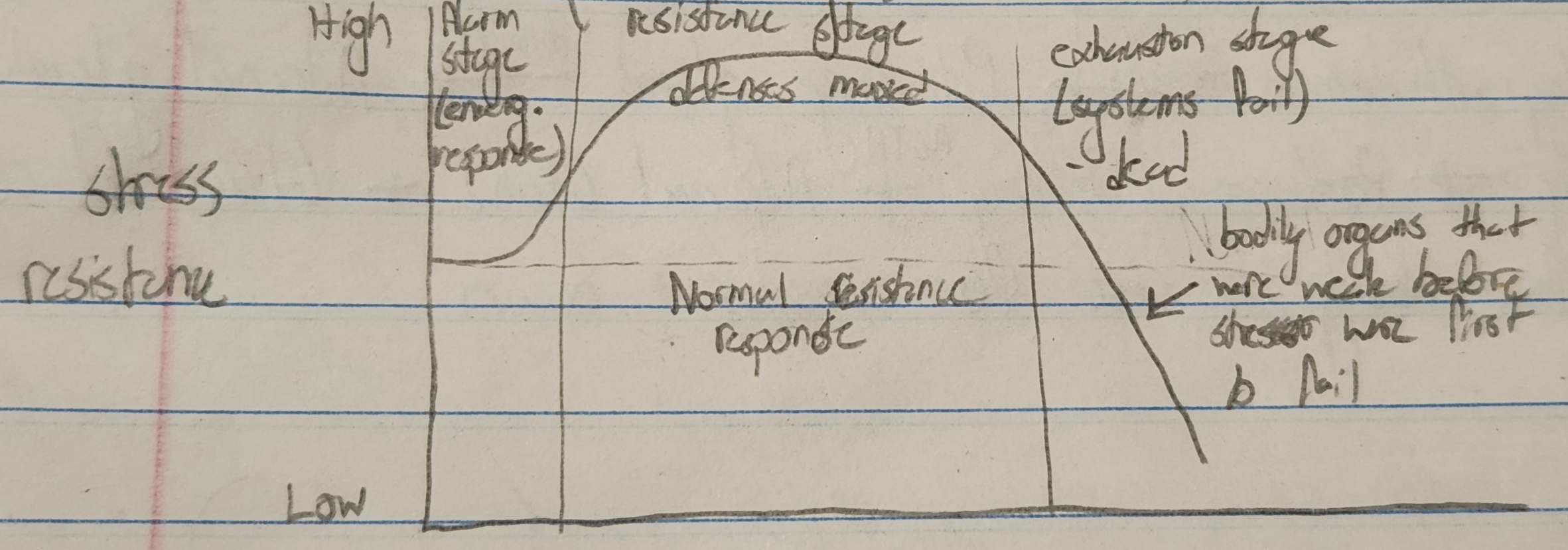
Alarm Stage (Emergency response)
What is perceived + experienced as a stressor varies between individuals
Primary appraisal
Is this stressful?
Mount an immediate defense or not?
Does this engage the alarm reaction?
Perceiving a stimulus as stressful
The loss of control due to unanticipated factors increases the likelihood that the event will be appraised as stressful
Primary cognitive appraisal

The perception of Coping
Modifications of of alarm stage → secondary appraisals of stressful event
What will I do?
Can I cope?
Do I have the problem-solving skills?
Control?
What determines the pathological consequences of the stress response?
The predictability of shock
Resistance Stage(max resources mobilized)
Moderate stress = coping + resolution → engagement of additional resources to restore homeostasis
Both physiological mechanisms + behavioral strategies are involved
Physiological = engage the hypothalamic-pituitary-adrenal (HPA) axis
HPA axis
Mobilization to restore homeostasis
Stressful event
Brain → Hypothalamus → chemical message → Pituitary gland → hormones → Adrenal gland → cortisol
Hypothalamus → CRF → Anterior Pituitary → Posterior Pituitary → Adrenal gland → Glucocorticoids
Glucocorticoids takes sugar from body to use for muscles + brain
Acute Stress Response
Shift from energy storage to energy use
Increased cognition
Increased cardiovascular tone
Decreased digestion
Decreased growth
Decreased reproduction
Altered immune function + inflammatory responses
Increase analgesia
Emotion-focused coping
Does nothing to help with stress
Minimizing avoidance, blaming others, drugs, too much/too little eating, crying, exercise, etc
Outlets for frustration may be positive in the short term
Displacement behaviors (pacing around, swinging legs, biting nails)
Problem-focused coping
Face the problem
Accept responsibility + culpability, tackling problem, asking for help, accepting injustices, realizing some things are out of control
The stress response does not exhaust! (Robert Sapolsky)
Prolonged stress → prolonged physiological responses to restore homeostasis
Stress kills brain cells that moderate / regulate hormones
Pathology results from the very process that are adaptive in the short term
Increased likelihood of emotion-focused coping strategies
Pathological state associated with chronic stress
Fatigue
Myopathy
Steroid diabetes
Hypertension
Peptic ulcers
Psychological dwarfism
Impotence
Anovulation
Loss of libido
Impaired disease resistance
Cancer
Accelerated neural degeneration during aging
What are the 2 components of consciousness + subjective experiences?
1) Contents of consciousness
2) Level of consciousness
How do we sense our worlds?
Sensation is our sense organs’ detection of + response to external stimulus
Perception is brain’s processing of detected signals that results in internal rep. stimuli
Asomatognosia (unilateral neglect)
No body knowledge - one side doesn’t “exist”
Phantom Limbs
Lost sensory receptors but can still sense pain from those areas
Hallucinations
Mental illness, stimulant drugs (cocaine, meth)
What is the difference between sleeping and a coma?
The perception of time
Glasgow Coma Scale
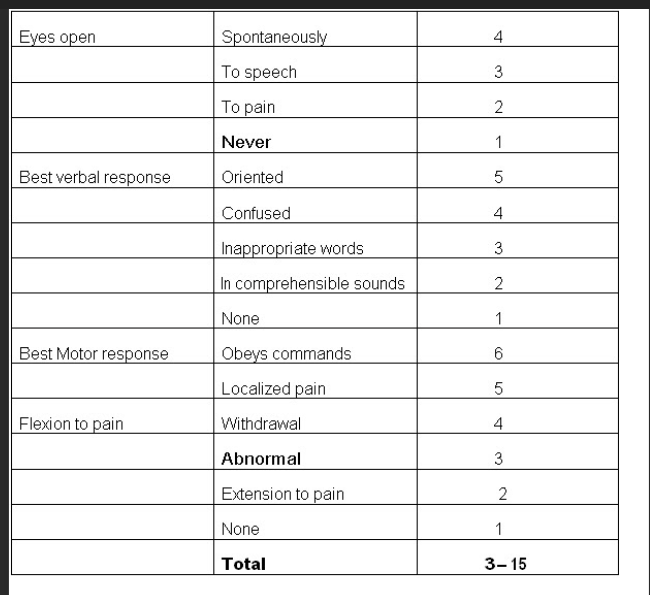
Reticular Activation System
Responsible for sending info to hypothalamus → arousal center
Regular sleep
Slow wave sleep - pedestrian dreams (black + white, boring)
Beta waves
Awake + alert
Alpha waves
Getting sleepy
Stage 1 (Theta waves)
Just falling asleep, easily woken up
Stage 2
Sleep spindles
K-Complexes → no specific function
Stage 3 (Delta waves)
Stage 4
Straight konked out, hard to get woken up
Stays in this cycle for ~1.5 hours
Characteristics of stages of non-REM sleep
Stage 1: Theta waves appear
Light sleep, person still claims to be awake
Stage 2: Sleep spindles, K-Complexes
Person definitely asleep, but responds to noise
Stage 3 + Stage 4: Delta activity
Very deep sleep; nonresponsive to most stimuli + slow to awake
REM sleep
Low amplitude, irregular EEG = similar to those found in waking brain
Begins 70-90 min into sleep cycle
Changes in physiological pattern including increased heart rate, darting eyes, twitching hands + feet + face
Most people awoken during REM report dreaming
Technicolor (funky) dreams → wild stuff
What is the function of sleep?
Repair + restoration
Downtime to employ process that’ll restore us back to health
Consolidation of memories
Remember more if you sleep better
Safety / adaptive behavior
How long do you have to speed eat?
What is the function of REM sleep?
Activation - Synthesis
Debugging the system to make it run better
Hobson - Brain needs to run when no sensory is coming in
Activity in the absence of external stimuli + normal brain activity
Threat reversal
Revonsuo → preparing for what’s to come
Rehearsal for real-life situations
Circadian Rhythm
Biological activities that rise + fall along a 24-hour cycle
Triggered at appropriate times by brain structures called biological clocks
The master Clock: Suprachiasmatic nucleus of the hypothalamus
Set by factors in the environment (light)
The pineal gland + melatonin
How do drugs affect behavior?
Drugs affect behavior + mental processes through alterations of conscious awareness
The electrical + chemical communication within + between neurons is the target of drug action
Mechanisms of drug action
Drugs can be agonists → mimic / potentiate the actions of neurotransmitters
Fit into same receptor, potentiate release, block reuptake
Drugs can be antagonists → block / decrease the action of neurotransmitters
Block a receptor, block synthesis, speed up metabolism
CNS Depressants
Slow (depress) activity of the central nervous system
GABA agonists + Glutamate antagonists
Ethyl alcohol, barbiturates, minor tranquilizers (benzodiazepines), anesthetics, inhalants of abuse
After long term use withdrawal symptoms will occur (seizures, tremors)
CNS Stimulants
Increased activity of the nervous system; General stimulants vs. Psychostimulants
General stimulus
Agonists for various transmitters
Caffeine, nicotine
Psychostimulants
Specifically target the monoamine transporter: cocaine vs. d-amphetamine
Cocaine, methylphenidate; ephedra; the rest of the amphetamines (MDMA=ecstasy)
Amphetamines look almost identical to dopamine → changes the flow direction of reuptake
Opioids (Opiates; “Narcotics”)
Depress nervous system activity (shut down brain stem)
Reduce pain + produce euphoria
Agonists for the Endogenous opioid system
Hallucinogens (“Psychedelics”)
Affect perception, distort reality
A catch-all category
LSD, mescaline, psilocybin, marijuana, PCP, ketamine
Agonists and/or antagonists for various transmitters
Cannabis: an agonist for the endogenous cannabinoid system - the natural ligand for which is anandamide → retrograde messenger
Psychological factors
Same amount for same drug may produce different effects on different people
Some may feel euphoria, some may feel fear
Opiate or Opioid?
Opioid: Class of drugs that are derived from Opium (poppy)
Opiate: Alkaloid substances derived from Opium (natural)
Opium → natural
Morphine → natural
Codeine → natural
Heroin → Semisynthetic
Oxycodone → Semisynthetic
Fentanyl → synthetic
Factors that can influence the effect
Context (conditioned cues)
Past experiences with the drug
The user’s physical + psychological state
Your physiology
Endogenous attention
Attention that is directed voluntarily
Exogenous attention
Attention that is directed involuntarily by a stimulus
You see an accident on the side of the road and cannot help but slow down to look at the traumatic scene. Why?
Exogenous attention occurs when attention is unintentionally shifted to an emotional stimulus
Why should you avoid using a laptop during lectures?
Laptop use in the classroom may shift attention away from the lecture, leading you to miss or superficially process info
Priming
A facilitation in the response to a stimulus due to recent experience with that stimulus or a related stimulus
Subliminal Perception
The processing of info by sensory systems without conscious awarness
Which type of subliminal messages are most likely to affect behavior?
Messages that invoke emotion or motivation may subtly shift behavior, but such messages do not affect complex behaviors like buying or self-confidence
Automatic processing
Occurs when a task is so well learned that we can do it without much attention → driving, walking, understanding the meaning of words
Controlled processing
Slower, helps people perform in complex or novel situations.
When Tara was learning to knit, she had to pay attention to every stitch. Now she can knit while watching television. Why can she knit now without giving it full attention?
Learning a complex task like knitting requires controlled processing. Once you learn the task, it becomes automatic + no loner requires full attention
Meditation
A mental procedure that focuses attention on an external object, an internal event, or a sense of awareness
Suppose a person meditating focuses on thoughts of waves rolling onto a beautiful beach. Is the person practicing concentrative meditation or mindfulness meditation?
Concentrative, b/c the person is focusing on a specific image
Does showing that long-term meditators have less age-related change in brain structure prove meditation reduces neural aging and decline?
No, correlation does not equal causation. Those who practice mediation may also have other lifestyle differences that affect brain aging.
Flow (textbook definition)
A particular kind of experience that is so engrossing + enjoyable that it is worth doing for its own sake even thought it may have no consequences outside itself. An optimal experience in that the activity is completely absorbing + satisfying + seems to happen automatically.
What is flow?
The state of being deeply immersed in a completely enjoyable + satisfying experience that may have no consequences beyond itself.
Hypnosis
A social interaction during which a person, responding to suggestion, experiences changes in memory, perception, and/or voluntary action.
Posthypnotic suggestions
After the hypnosis session, the listener will experience a change in memory, perception, or voluntary action.
Neodissociation theory of hypnosis
Hypnosis is a trancelike state in which conscious awareness is separated, or dissociated, from other aspects of consciousness.
Can everyone be hypnotized?
Hypnotic suggestibility varies between individuals + is related to personal qualities such as being focused, imaginative, easily absorbed, and willing to participate.
What hormone, released by the pineal gland, promotes sleep?
Melatonin
Dreams
Products of an altered state of consciousness in which images and fantasies are confused with reality.
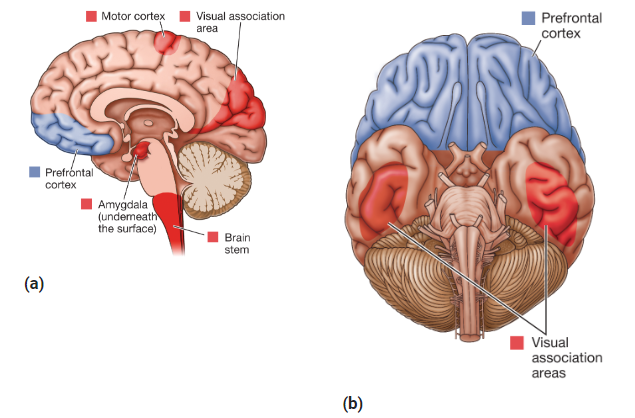
Brain Regions and REM Dreams
These two views of the brain show the regions that are activated (shown in red) and deactivated (shown in blue) during REM sleep. (a) As seen here from the side, the motor cortex, brain stem, and visual association areas are activated, as are brain regions involved in motivation, emotion, and reward (e.g., the amygdala). A region of the prefrontal cortex is deactivation. (b) As shown here from below, other visual association areas are activated as well. (This view also reveals the full size of the prefrontal cortex.)
Activation-synthesis hypothesis
A hypothesis of dreaming proposing that the brain tries to make sense of random brain activity that occurs during sleep by synthesizing the activity with stored memories.
Is a dream about folding + putting away laundry more likely to occur during REM sleep or non-REM sleep?
Non-REM sleep, when dreams are often dull + lack bizarre qualities typical of REM dreams
Restorative theory
Sleep allows the body, including the brain, to rest + repair itself
Circadian rhythm theory
Sleep has evolved to keep animals quiet + inactive during times of the day when there is the greatest danger.
After an exhausting day helping your friend move into a new apartment, you sleep a great deal that night. Which theory of sleep does this behavior support?
The restorative theory
Insomnia
A disorder characterized by an inability to sleep that causes significant problems in daily living
Obstructive sleep apnea
A disorder in which people, while asleep, stop breathing b/c their throat closes; the condition results in frequent awakenings during the night.
Narcolepsy
A sleep disorder in which people experience excessive sleepiness during normal waking hours, sometimes going limp + collapsing
REM behavior disorder
the normal paralysis that accompanies REM sleep is disabled. People with this disorder act out their dreams while sleeping.
Sleepwalking (somnambulism)
occurs during slow-wave sleep, typically within the first hour or two after falling asleep. During an episode, the person is glassy-eyed and seems disconnected from people + surroundings.
Suppose a person frequently has trouble falling asleep but is unbothered + functions well enough in daily life. Does this person have insomnia?
No, insomnia is a sleep disorder that affects mental health + causes functional impairments in a person’s daily life.
What time should you go to bed if you want to establish good sleeping habits?
The specific time depends on you, but it should be the same time every night
How does unresponsive wakefulness syndrome differ from brain death?
Those in a state of unresponsive wakefulness show some abnormal brain function, while those who are brain dead show no brain function.
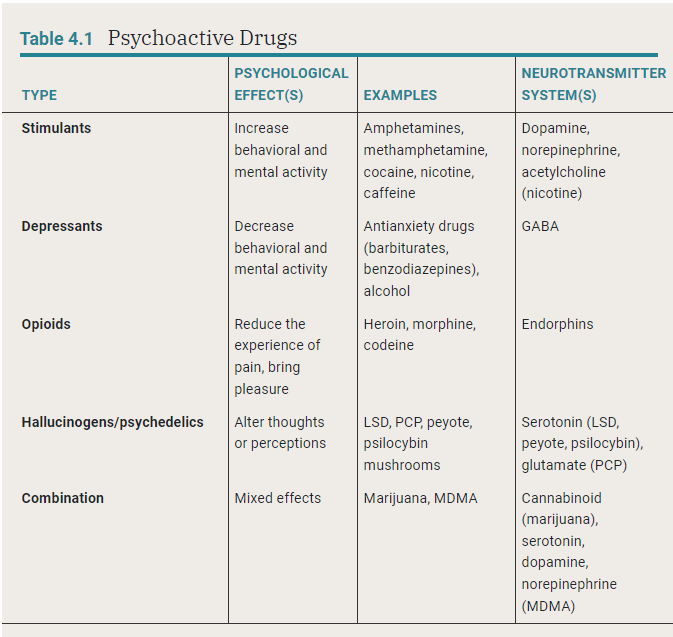
Psychoactive Drugs
Which type of drug heightens behavioral and mental activity?
Stimulants, such as caffeine, nicotine, amphetamines, and cocaine
What type of drug is in Adderall, used to treat ADHD?
An amphetamine (Stimulant)
What is the definition of binge drinking?
Drinking 5 or more drinks in one setting
What are the brainwaves from fastest to slowest?
Beta, alpha, theta, delta
What are the steps for sensation and perception?
The Stimulus
Sensation
Transmission
Translation
Perception + Attention
The stimulus
What is detected
The sensation
Detection + Transduction of the stimulus into action potentials
The Transmission
Action Potentials travel to primary cortical area for processing
What is the pathway?
Ultimately the thalamus
Is it multisynaptic?
Not sure
Where is the info processed along that pathway?
Also not sure
The translation (Transduction)
The process by which sensory stimuli are converted to neural signals the brain can interpret.
Reception of the Action Potentials
Where does the info arrive in the central cortex?
Primary cortexes for each sense
What association areas are recruited to process that input?
Sensory receptors → thalamus (except smell) → specific region of the cerebral cortex for each sense
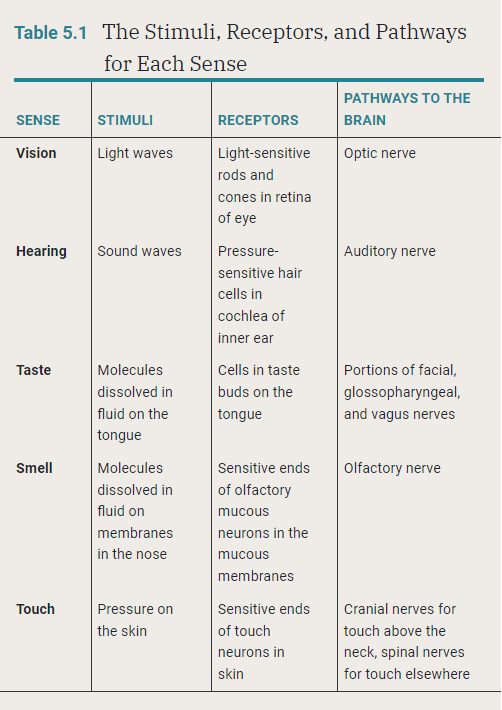
The perception + attention
Did you register the input?
Don’t register most things every day
Did you experience the stimulus?
What did you experience?
Further processing, organizing, and interpretation of sensory info
How do we sense chemicals in the world?
The chemical senses → Gustation + Olfaction
How do we sense mechanical energy from the environment?
Mechanical senses → Somatosensory + Audition
Fine touch (haptic system) → pain is perceived by deep tissue receptors
Temperature
Pressure (light pressure - okay, heavy pressure - ouch)
Body position + movement
Pain (early + late pain)
Haptic system
Uses the hair on body to detect touch (nerve endings wrapped around hair follicles)
Disk structures under skin react to pressure on skin
Anything that provides enough input will cause nerves to go ouch
Proprioception + kinesthesia
The ability to sense the position + movement of one’s body parts
Many systems involved: receptors in muscles, joints, skin; visual feedback
Vestibular sense
The ability to sense changes in acceleration, posture
Inner ear organs that contribute: semicircular canals, vestibular sacks